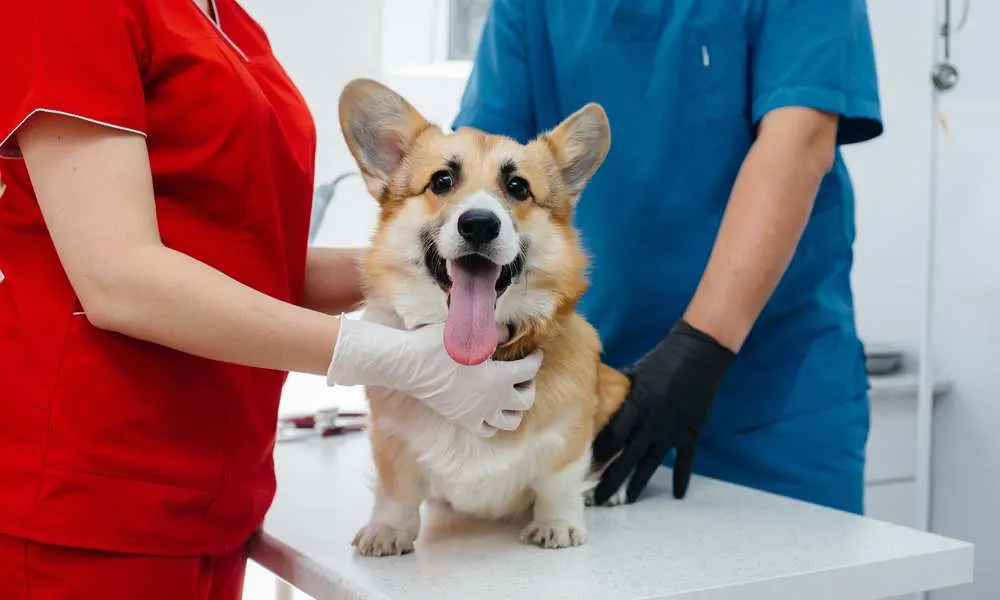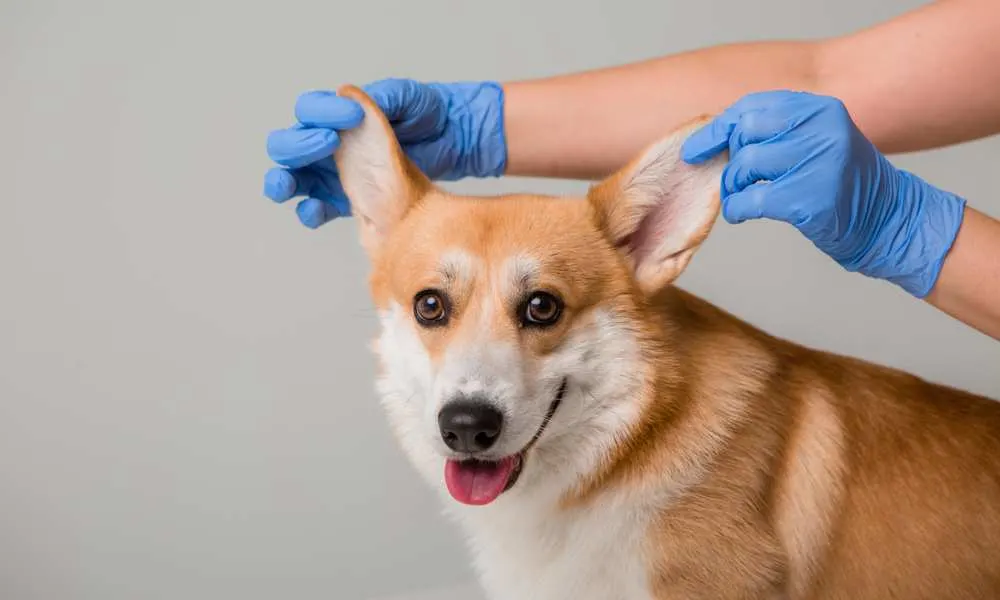A healthy dog is a happy dog, and you should remember that. Health issues differ between breeds. While some dogs are considered perfectly healthy, others have to watch out for many things, and their owner has to pay regular visits to the vet.
Corgi dogs are not in the best of health, so you have to be careful with this. Back pain in corgis is one of their most common problems, and they can suffer a lot if it is not treated right away. Of course, this is not the only problem that bothers this breed.
If you are interested in everything concerning corgi health and how to provide appropriate care, continue reading this article. We will try to answer all your questions and provide you with some effective solutions.

IVDD – Corgi’s Nightmare
When talking about back problems, IVDD – Intervertebral Disc Disease is at the very top of the list. Many dog breeds have this problem, but our concern is the corgi. So, the question is:
Do corgis have back issues?
Yes, it is very common for the Cardigan and Pembroke Welsh corgi to suffer from IVDD. But what exactly is this, and how to prevent back problems in corgis?
Let’s start by explaining this disease in detail.
Intervertebral Disc Disease mostly affects dwarf dogs with regular trunks but shortened legs. Among the most common dog breeds affected by this are Dachshund, Shih Tzu, and The Corgi.
The dog’s spine is composed of numerous vertebrates responsible for connecting and protecting the entire spinal cord. The Intervertebral Disc Disease separates the vertebrates, and it had two forms:
- Protrusion of the disc
- Extrusion of the disc
The most frequent question any vet will hear is:
Are corgis prone to back problems and when do they occur?
Back problems in corgis can go from suffering immense pain to total paralysis and they occur in the early stages of life.
Some possible signs that your corgi is suffering from IVDD are:
- Back or neck pain
- Difficulty walking
- Stumbling
- Sudden paralysis (worst case scenario)
How much your corgi suffers and the success of the treatment depends on the time when you discover the disease.
The Intervertebral Disc Disease can be separated into cervical and thoracolumbar IVDD. The cervical affects C2-3 and C3-4 discs, and it is shown in the dog’s reluctance to go for a walk or even keep their head held up. On the other hand, the thoracolumbar affects 85% of your corgi’s body and ends with not using their back legs at all.
To answer your question – do corgis have back problems? Yes, many of them are devastating to watch, so you should look for a proper treatment as soon as you find out.
Read Also: Back Leg Problems – Do Corgis Have Leg Problems?
Hansen Types
The Intervertebral Disc Disease is very complex, and it is characterized by types:
- Hansen type I disc disease
- Hansen type II disc disease
- Hansen type III disc disease
Now, we are going to explain these three types and how exactly do they affect your corgi.
| Hansen type I disc disease | This is the most common type, and it can occur with dogs up to 2 years of age. This type implies “extrusion of the disc” – the disc is mostly damaged. Your corgi suffers to move naturally because the spine is less flexible. The signs range from pain to paralysis, depending on when you notice it. No matter the time, you should seek help as soon as you notice any weakness in your corgi’s movements. |
| Hansen type II disc disease | The type II disc disease is similar to a human disc disease, and instead of extrusion, we have protrusion of the disc. This can be very painful for your dog and lead to bleeding and compression. The signs of this develop progressively, so it would be best for your dog if you engage in some kind of treatment during the early stages. This occurs between 5-12 years of the dog’s life. |
| Hansen type III disc disease | This type is also known as the “high-velocity low volume” disc disease, and it causes the normal nucleus to explode from a sudden tear. With this type, the dog can recover without having any surgical endeavors. The most common sign of this type is the “drunken sailor” walk. Although this type does not require a surgery, it can still be fatal. |

IVDD Treatments
You can treat Intervertebral Disc Disease in two ways – surgery or no surgery.
Non-surgical treatments are meant for dogs who have mild signs of IVDD, or if he is already recovering from some other spinal surgery. Some owners are also afraid of letting their pet take on any kind of surgery, but this is not always the right type of mindset an owner should have.
A non-surgical treatment of the IVDD is also referred to as conservative treatment or management. Why? Because this aims to help the dog recover and start walking by feeling comfortable with his exercise. This way of treating a disease also contributes to improving bladder and bowel control.
To be more precise, here is what one regular non-surgical IVDD treatment includes:
- Pain relief
- Activity modification (avoiding excessive running or jumping, engaging in safe and basic exercises, avoiding fatigue, constant supervision by the doctor, proper dietary care, mental stimulation, etc.)
- Being admitted to a veterinary hospital
- Managing bladder and bowel control as well as any breathing problems your dog can have.
In the past, dogs suffering from IVDD were either given strong medication and released home or underwent surgery. Nowadays, different up-to-date methods have been developed, and dogs do not suffer as much as they did in the past.
When it comes to pain-relief medication, the medicine industry has evolved, and many new and effective drugs were distributed to veterinary hospitals. They mostly include NSAIDs – non-steroidal anti-inflammatory drugs, which help the dog feel better during the treatments.
If you are thinking of engaging in this type of treatment, it is necessary for you and your dog first to visit the vet and consult with a neurologist. Sometimes, the disease has developed so much that non-surgical interventions will be of no help.
On the other hand, when considering surgery, there are two types of surgeries:
- The first one is called fenestration surgery. This is a surgery that can be done quickly, and it does not require some special equipment. This also means that it is intended for dogs where the IVDD has developed that much. This surgery aims to limit any further disc extrusion.
- The other one is called decompressive surgery, and it is a bit more complicated than the previous one. During the decompressive surgery, the disc is removed from the vertebral canal. Because of this, it requires more time and special equipment. The way in which this procedure is performed depends on the dog and how much the spine and neck have been damaged.
The time limit of both surgeries depends on the case itself, and it can take anywhere from one to three hours.

Aftercare
Of course, you may be wondering what happens to your precious pup after such a surgery. You have no reason to worry because, after this lengthy procedure, your dog will be taken care of properly by a team of nurses.
Immediately after the procedure, your dog will have a chance to recover from the anesthetic. After the dose has worn off, he will be prescribed proper therapy with any additional medication (if needed).
If the specialist who was in charge of the surgery sees a reason, he will redirect your dog to a surgical ward to continue the nursing care – but don’t worry, these cases are sporadic.
Bearing in mind that these procedures are very complex and essential to your dog, you should expect a noticeable reduction in movement, some weakness, etc.
There is no precise time during which your dog has to stay in the hospital. This depends on the dog, and he is free to go home after he has successfully recovered from the medication and is able to urinate regularly. Of course, before leaving the hospital, he will have to be assessed by the physiotherapist in charge.
After leaving the hospital, some dogs continue to walk and enjoy life, while others are deprived of these possibilities and continue functioning with a mobility cart.
The important thing is that you shouldn’t lose hope if your dog ends up needing one of these. Although it may be hard for both you and the dog, he will adjust as time passes. In order for your dog to feel comfortable using mobility carts, you should pay attention that you get the measurement rights – otherwise, it’s just more unnecessary pain.
8 Ways To Minimize Back Pain In Corgis
As we already mentioned, there are numerous new and effective remedies and therapies for dogs who suffer from serious diseases – back pain in this case. Before deciding to take a big step and go to surgery, people experiment with different therapy methods.
Here are eight ways in which you can help minimize back pain in dogs:
| Hydrotherapy | This is similar to physical therapy, and the exercises are performed in water. This has proven to be extremely helpful because the water reduces the pressure in the dog’s joints and muscles. |
| Laser therapy | Believe it or not, cold laser therapy is becoming more and more popular. During this treatment, the energy of the laser helps stimulate blood flow and improves muscle movement. |
| Ultrasound | An ultrasound is crucial because the waves produce heat levels, which reduce internal swelling and stimulate blood flow. |
| Acupuncture | This is an old Chinese medicine performed on both people and animals for hundreds of years. Unlike the previous ones, this might hurt a lot, and not every dog is willing to take part in this process. |
| Tui Na | Tui Na is a massage that often goes with the art of acupuncture for those who are not familiar. This involves massaging the entire spinal cord of the dog. |
| Herbal therapy | Instead of opting for exercise and medication, some owners like to stick to a healthy diet – all-natural – and herbal therapy is the right choice for them. This type of treatment includes specific foods mixed together, which contribute to muscle strengthening and blood flow. |
| Physical therapy | This is the most common therapy out there, and it involves the vet performing exercises with the dog and adjusting his joints and muscles. |
| Traditional pain medication | NSAIDs, which we mentioned earlier, are becoming more and more popular with dogs who are not so willing to try actual physical therapy. Just because we are talking about medication and not exercise, it doesn’t mean that something can’t go wrong. It would be best if you were careful what dose you give to your dog. |

Watch Out For Other Diseases As Well
Unfortunately, back pain in the corgis is not the only problem you should be aware of. Knowing that this breed is not among the healthiest, they deal with a bunch of other health problems.
Here is a summary of the most common corgi health problems you should watch out for:
- Degenerative myelopathy (DM) – this is a neurological condition that begins in the spinal cord and continues throughout the entire body of the corgi. Corgis with this disease will struggle to move and stand for a long time. Although this disease makes progress slowly, your corgi might still end up paralyzed.
- Pregnancy complications – female corgis often deal with a lot of difficulties during their pregnancy. Unfortunately, this is something that is inherited and unpredictable. If you have a female corgi, regular check-ups with the vet will help a lot.
- Eye conditions – eye problems are very common with the corgi breed. They vary – from mild eye problems to blindness. If you notice this on time, it can be healed with medication. Just like humans, your corgi can have cataracts or conjunctivitis.
Read More: Genetic Diseases In Corgis

Keep Your Corgi Healthy
Just like we said in the beginning – a healthy dog is a happy dog. As a responsible owner, you should take care of your dog the way you take care of yourself and your loved ones.
Here are a couple of tips on how to keep your corgi healthy and happy.
- Provide your corgi with daily exercises and activities – he has a lot of energy, and this is a perfect way to channel it.
- Keep your corgi on a healthy diet – choose the food you give to your corgi. Make sure that he eats all his vitamins and avoid making him overweight.
- Take care of your corgi’s coat – during the year, corgis shed a lot, and you must take care of all that hair. If you ignore it, bacteria will pile up, and your corgi might catch some disease.
- Challenge your corgi mentally – corgis are very smart dogs, and they love to explore and investigate. Just like humans, the mental health of a dog is also very important. Keep your corgi interested, and he will be in a good mood.
See Also: Why Does My Corgi Arch His Back?

Conclusion
Intervertebral Disc Disease is one of the most common back issues. Many dog breeds have this problem, and corgis seem to fit into this category as well. The best way to explain what this disease does is to affect the dog’s spine, and it separates the vertebrates.
Unfortunately, besides the Dachshund, which is at the top of the list, corgi dogs are also widely affected by this. This complex disease has three types: Hansen type I, II, and II disc disease. Each one differs from the other, and it is treated differently.
IVDD can be treated both non-surgically and surgically. The non-surgical methods involve the dog performing numerous activities and exercises with the vet, managing bladder control, etc. As far as surgical procedures go, there are two possible solutions – fenestration and decompressive surgery. They depend on how much the disease has developed.
After the surgery, your dog must spend some time in the hospital recovering. After that, while some dogs continue walking on their own, others have to rely on a mobility cart. Before buying it, check the measurements so that your dog feels comfortable.
Nowadays, apart from surgeries, there are a lot of “natural” treatments that owners find useful. Among these, we have hydrotherapy, physical therapy, acupuncture for dogs, and even herbal therapy.
Corgis might be a little demanding when it comes to maintaining their health, so you should be extra careful and provide them with daily exercise, good food, and proper grooming.

